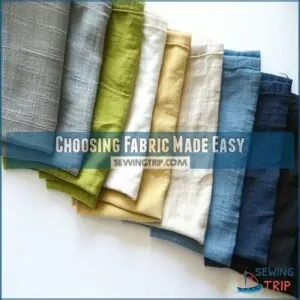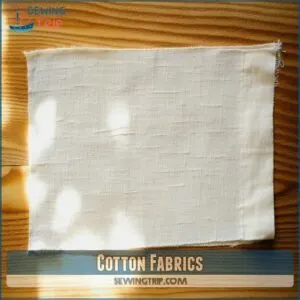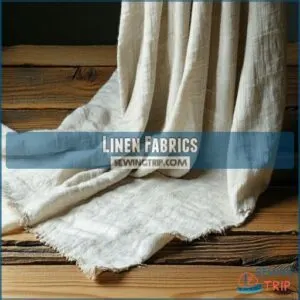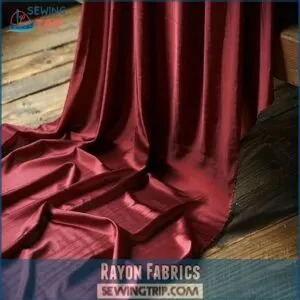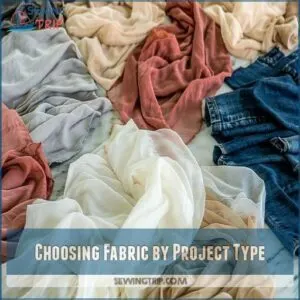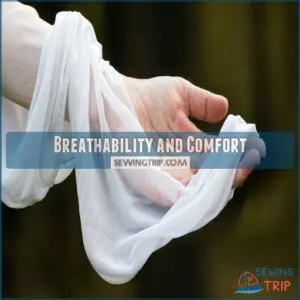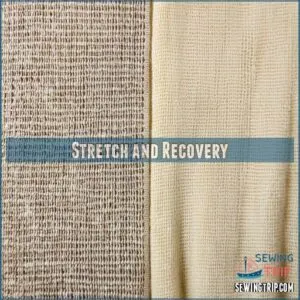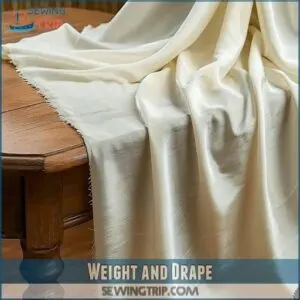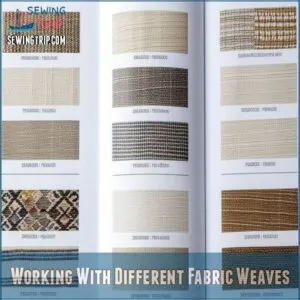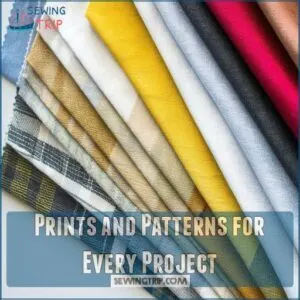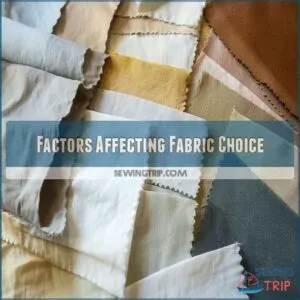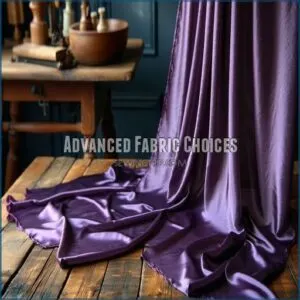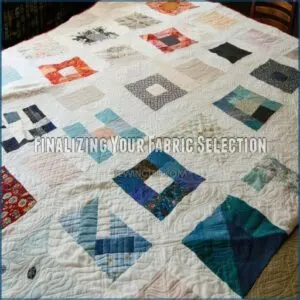This site is supported by our readers. We may earn a commission, at no cost to you, if you purchase through links.
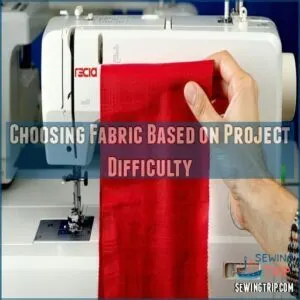
For beginners, cotton is your best friend: easy to handle and forgiving.
Slightly more advanced? Try linen, but be prepared for some wrinkles.
Rayon offers a slippery challenge for seasoned pros, demanding nimble fingers.
Consider the project’s end use—no one wants a wool swimsuit!
Also, keep your budget in mind; lighter fabrics often cost less.
If you’re crafting complex designs, opt for fabrics with a bit of give.
Now that you’re armed with fabric wisdom, imagine the masterpieces you’ll create with just the right touch!
Table Of Contents
- Key Takeaways
- Choosing Fabric Made Easy
- Choosing Fabric Based on Project Difficulty
- Fabric Types for Beginners
- Choosing Fabric by Project Type
- Understanding Fabric Properties
- Working With Different Fabric Weaves
- Prints and Patterns for Every Project
- Factors Affecting Fabric Choice
- Advanced Fabric Choices
- Finalizing Your Fabric Selection
- Frequently Asked Questions (FAQs)
- Conclusion
Key Takeaways
- You should choose cotton if you’re a beginner—it’s easy to handle and forgiving, making it perfect for starting projects.
- Always match your fabric to the project’s end use and your skill level; complex designs may require fabrics with some stretch.
- Be mindful of your budget; lightweight fabrics often cost less and are suitable for simple projects.
- Consider the care requirements and sustainability of your fabric choice to ensure your creation lasts and is eco-friendly.
Choosing Fabric Made Easy
Choosing the right fabric doesn’t have to be a labyrinth of confusion—it’s all about matching the fabric to your project and skill level.
Choosing the right fabric doesn’t have to be a labyrinth of confusion—it’s all about matching the fabric to your project and skill level.
Whether you’re whipping up a cozy cotton quilt or tackling a sleek satin dress, you’ll find the perfect fabric fit by keeping it simple and fun!
Whether you’re whipping up a cozy cotton quilt or tackling a sleek satin dress, you’ll find the perfect fabric fit by keeping it simple and fun!
Assessing Project Requirements
Before diving into fabric choices, consider your project’s timeline and budget constraints—do they align with your vision?
Matching fabric to your project is like finding the right puzzle piece.
Assess the design’s complexity and make sure your sewing tools are up to the task.
Balancing practicality and creativity ensures a smooth start to your sewing journey.
Evaluating Skill Level
Figuring out your project needs sets the stage, but figuring out your skill level is like picking the right gear for a hike.
Beginner-friendly projects boost your sewing confidence without overwhelming you.
If your stitches are still wobbly, opt for simpler fabric types.
Skill level assessment helps match fabric to project complexity, making each creation a win.
Choosing Fabric Based on Project Difficulty
Picking the right fabric can make or break your project, so let’s match your skills to the perfect material!
Choosing wisely means less frustration and more fun, resulting in a finished piece you’ll actually love.
Ethical Use of AI
When you’re picking the right fabric for a tricky project, remember that AI has its ethical side too.
It’s important to think about AI accountability in your choices.
For instance, you can find a range of fabrics suitable for different project difficulties on websites like Fabric Difficulty Level.
Here’s why it matters:
- AI transparency: Know how decisions are made.
- AI regulation impact: Stay updated on rules.
- AI ethics frameworks: Follow best practices.
- AI bias mitigation: Choose fairly, responsibly.
AI Bias Concerns
Worried AI might play favorites when choosing fabric for your projects?
With AI Ethics in the spotlight, it’s important to tackle data fairness head-on.
Bias Mitigation makes sure your algorithms don’t skew results, making choices feel balanced, responsible, and free from prejudice.
Remember, Responsible AI acts like your sewing companion, helping you navigate fabric choices without hidden agendas.
Transparency in Algorithms
Algorithm bias often leaves people scratching their heads, wondering what’s behind the magic curtain.
Transparency in algorithms promises a clearer view, helping you avoid the dreaded black box models.
Here’s how to keep things on the up-and-up:
- Embrace explainable AI for peace of mind.
- Prioritize data privacy at every step.
- Make sure ethical AI decisions align with your values.
AI Impact on Jobs
AI’s impact on jobs can feel like watching a plot twist unfold, stirring a mix of excitement and dread.
While automation might shuffle roles, it also carves new paths in the job market.
Build AI skills to bridge the knowledge gap—it’s key to managing the future of work.
As industries evolve, ethical AI practices become essential.
Fabric Types for Beginners
Starting your sewing journey can be as thrilling as it’s overwhelming.
Beginner-friendly fabrics like cotton, linen, and rayon will help you confidently tackle your first projects without breaking a sweat (or too many needles).
Cotton Fabrics
When picking cotton fabric, you’ve snagged the jack-of-all-trades of textiles. It’s perfect for beginners, but what about specifics?
- Care: Easy, just wash and go.
- Weight: From light voile to sturdy denim; your call.
- Types: Endless, with prints galore.
- Uses: Garments, quilts, crafts—dive in and create!
Linen Fabrics
Linen’s got that effortlessly cool vibe, right?
Linen wrinkles are part of its charm, but you can steam them out if you want a crisper look.
For sewing, use a sharp needle; linen’s texture can be a bit tricky.
With a little practice and these linen sewing tips, your linen projects will look amazing!
Proper linen care helps your creations last.
Enjoy the beautiful linen drape!
Rayon Fabrics
Rayon presents a great fabric choice with its dream-like drape and flow, perfect for clothing projects.
While linen might keep things cool, rayon excels in adding that silky touch.
Rayon care requires gentle handling to maintain its beauty.
Opt for rayon blends when durability matters, and when sewing, consider stabilizing techniques to prevent slipping.
Embrace rayon’s versatility!
Choosing Fabric by Project Type
When choosing fabric for your project, think about what you’re making—garments, home decor, or funky accessories—because each requires different characteristics.
You wouldn’t use heavy wool for a summer dress, just like you wouldn’t wear flip-flops to a snowstorm!
Garment Construction
Sewing garments is like crafting your perfect outfit puzzle.
Consider how fabric manipulation affects garment fit and pattern matching.
When choosing a project, keep in mind the importance of mastering essential skills for beginners, such as straight stitching and seam allowances.
Cotton is a breeze for beginners due to its forgiving nature, perfect for practicing seam finishes.
To master various sewing techniques for future projects, it’s essential to understand the basics of sewing patterns, including choosing the right pattern, and then focus on mastering those techniques for future projects.
With each stitch, you’re piecing together your unique style statement, one seam at a time.
Home Decor Projects
When choosing fabric for home decor projects, focus on weight and scale.
Heavy, drapey fabrics like velvet or chenille create cozy, luxurious vibes.
Lightweight, fluid fabrics like linen or silk add an airy, elegant touch.
Consider the size of your project – large-scale prints shine on curtains and upholstery, while small-scale patterns complement pillows and throws.
Accessories and Crafts
Crafting accessories and DIY projects opens up a whole new world of fabric possibilities.
Look for lightweight, drapey fabrics that are easy to work with, like cotton, linen, or rayon.
Avoid heavyweight or stiff materials that could overwhelm smaller pieces.
Some favorites for accessories include:
- Silky charmeuse for scarves
- Crisp cotton for tote bags
- Soft jersey for headbands
- Metallic lamé for statement jewelry
Understanding Fabric Properties
Understanding a fabric’s properties, such as its stretch percentage, which can range from moderate like jersey fabric options, will make all the difference in your sewing projects. From breathability to stretch, understanding these key characteristics is the secret to creating fabrics that truly shine.
Breathability and Comfort
Breathability and comfort are key when selecting fabric for your project.
Look for natural fibers like cotton and linen that allow air to circulate, keeping you cool and comfortable.
For a wide selection of natural fiber fabrics, check out natural fiber fabric options.
Certain synthetics, like polyester, can trap heat and moisture, making them less ideal for warm-weather wear.
Pay attention to how the fabric feels against your skin.
Stretch and Recovery
Stretch and recovery are essential fabric properties to keep in mind.
Knit fabrics naturally stretch and recover, while woven fabrics have less give.
Look for the stretch percentage – the higher, the stretchier.
Quality fabrics will bounce back without losing shape.
Choosing the right stretch for your project makes all the difference in comfort and fit.
Weight and Drape
Fabric weight matters for your projects – lighter fabrics like voile drape gracefully, while heavier cottons lend more structure.
Consider the weight that best suits your style and intended use.
For instance, natural fibers like cotton, linen, wool, silk, and hemp offering breathability.
Breathable linens keep you cool, while woolier blends provide extra warmth.
Visualize how the fabric will move and fall on your finished piece.
Working With Different Fabric Weaves
When tackling a new sewing project, understanding different fabric weaves is as important as choosing the fabric itself.
When selecting a fabric for your project, it’s essential to consider the properties of woven fabrics, such as their density and breathability, which can be affected by the fabric count and fiber type. Woven fabrics and knits have different properties that can impact the success of your project.
Whether you’re wrangling with sturdy woven fabrics or embracing the stretch of knits, knowing their quirks can make or break your creative endeavor.
Woven Fabrics
Woven fabrics are like that dependable friend who’s always there when you need them. They offer stability and a bit of structure, perfect for projects requiring precision.
You’ll want to keep these things in mind:
- Neat seams and sharp lines for a polished look.
- Effortless drape that flows naturally.
- Care instructions that suit your lifestyle.
Knit Fabrics
Explore knit fabrics, and you’re bound to find their stretch and recovery rewarding for projects that need flexibility, like shirts or leggings.
They drape well and are forgiving for beginners.
Just remember, using a ballpoint needle and adjusting your stitch length can make you feel like a sewing pro.
So, embrace knit fabrics, as they stretch your skills!
Specialty Fabrics
Let’s talk specialty fabrics. These aren’t your everyday materials; they add pizzazz.
Think: Delicate lace, perfect for adding a touch of elegance, but first, consider the fabric count and how it determines stitch size and project scale, as seen in cross stitch fabric basics.
Durable leather, ideal for long-lasting projects. Luxurious faux fur, adding warmth and whimsy.
Velvet, brocade, and other unique textiles each present their own exciting challenges and rewards—go for it!
Prints and Patterns for Every Project
Don’t let prints and patterns intimidate you – they’re the perfect way to add personality to any project!
From classic stripes to bold florals, there’s a fabric for every skill level and style.
Scaling Prints and Patterns
When choosing prints and patterns, consider the scale in relation to your project.
Large-scale prints work best for beginner sewers and bigger items like home decor, as they create a bold visual impact.
Opt for smaller, subtle patterns on garments or accessories to avoid overwhelming the final look.
The print’s repetition should also complement the fabric’s drape and flow.
Matching Prints to Fabric Type
Matching the scale of your print to the fabric type is key.
Delicate florals shine on floaty chiffons, while bold stripes pop on sturdy cottons.
Consider the drape of your fabric – crisp prints pair well with structured fabrics, while fluid prints elevate soft, drapey materials.
Experiment to find the perfect print-fabric harmony that brings your project to life.
Working With Large-Scale Prints
Working with large-scale prints takes a bit of strategy, but it’s worth the effort.
The key is aligning the pattern carefully as you sew.
Fabric drape is also essential – select a drapey fabric like rayon to complement the bold print.
And don’t forget to plan your layout wisely to maximize the impact.
With some smart sewing techniques, you can rock those statement-making large-scale prints.
Factors Affecting Fabric Choice
Choosing fabric is like picking the perfect sidekick for your sewing project.
From care requirements to your budget, there are several factors that’ll make your fabric choice a breeze – just don’t forget to give it a good feel before sealing the deal!
Care Requirements
Deciphering those care instructions on the label? Don’t sweat it!
The key is matching the fabric to the right cleaning method.
Cotton and linen? Easy! Toss ’em in the wash.
Wool and silk? Gently hand wash or dry clean.
Check the label, then tackle that stain with confidence.
Your threads will thank you!
| Fabric Type | Washing | Ironing | Dry Cleaning |
|---|---|---|---|
| Cotton | Machine | Medium | Not Required |
| Linen | Machine | Medium | Not Required |
| Wool | Hand | Low | Required |
| Silk | Hand | Low | Required |
Sustainability
When choosing fabrics, consider their sustainability.
Opt for ethically sourced materials like organic cotton or recycled polyester.
Look for eco-friendly dyes and finishes that reduce your environmental impact.
Sewing with sustainable practices, like repurposing scraps, can also make your projects more earth-friendly.
Going green in fashion feels good and looks great.
Budget Considerations
Saving the planet’s great, but let’s chat about saving some money on fabric. Fabric cost doesn’t have to break the bank; think smart.
- Project scale: Bigger projects mean more fabric.
- Value for money: Opt for durable options.
- Fabric sourcing: Check outlets and online.
- Discount opportunities: Watch sales.
- DIY spirit: Upcycling can cut costs and add charm.
Advanced Fabric Choices
Ready to take your sewing skills to the next level?
Get ready to explore the exciting world of advanced fabrics, where the possibilities are endless!
From high-performance activewear to luxurious silk, these specialty textiles will elevate your projects and leave your friends in awe.
Performance Fabrics
Performance fabrics are designed to improve comfort and functionality.
They offer features like moisture-wicking, compression, and breathability – perfect for activewear and athletic pursuits.
Look for fabrics that balance style, sustainability, and durability.
Seek out high-quality options that will keep you feeling your best, no matter the activity.
| Feature | Benefit |
|---|---|
| Moisture-Wicking | Keeps you dry and comfortable |
| Compression | Supports muscle groups for improved performance |
| Breathability | Regulates body temperature |
Luxe Fabrics
Luxe fabrics like silk, satin, velvet, and brocade elevate any sewing project.
These sumptuous materials add elegance, but they require extra care, especially when choosing the right fabric for a specific occasion, such as a formal evening gown.
Silk needs dry cleaning, while velvet may shrink if washed incorrectly.
Before diving in, research the unique properties of luxe fabrics to guarantee a polished, long-lasting result.
Finalizing Your Fabric Selection
Now that you’ve narrowed down your fabric options, it’s time to get hands-on.
Feel the fabric to check its weight, drape, and texture – these tactile details can make or break your project.
Once you’ve found the perfect match, don’t forget to do a quick color fastness test to make sure your fabric will hold up beautifully.
Feeling The Fabric
Feeling the fabric is essential when finalizing your fabric selection.
Run your fingers across the surface, get a sense of its texture – is it smooth or rough?
Gently tug and watch how it drapes.
Pay attention to the fabric’s weight and "hand feel" – how it bounces back when you squeeze it.
These tactile cues will help you envision how the fabric will perform.
Color Fastness
Checking a fabric’s colorfastness is important before purchasing.
Run your fingers along the grain to spot fading or bleeding dyes.
To avoid such issues, it’s also essential to choose the right dye, such as dyeing fabrics black, which can help achieve the desired color without compromising the fabric’s quality.
Always inquire about dye lot variations, as subtle shifts can impact your project.
Making The Final Decision
Imagine you’re assembling a puzzle, each piece like fabric swatches fitting into your project.
Think about your project budget and color choices, while ensuring fabric quality matches your plans.
You can find a wide variety of fabrics suitable for different project difficulties at fabric store websites.
Keep your sewing tools handy for testing out fabrics.
| Factor | Consideration |
|---|---|
| Fabric Swatches | Try before you buy |
| Budget | Stick to limits |
| Color Choices | Match your style |
Frequently Asked Questions (FAQs)
How do you choose a fabric for a sewing project?
Ever felt lost in a sea of fabric choices?
Consider the project’s purpose and your sewing skills.
Cotton’s great for beginners, while silk suits seasoned sewists.
Match fabric drape to design for a refined touch.
What if I choose the wrong fabric?
Choosing the wrong fabric can lead to fitting issues, discomfort, or an unsatisfactory look.
It’s like trying to fit a square peg in a round hole.
If it happens, repurpose your project or try again!
Why should I choose a different fabric?
Different fabrics behave differently. You might need a sturdy fabric for a durable project or a flowing one for drape. Choosing wrongly means redoing your work! So, pick wisely.
Which fabric is more difficult to sew on?
Did you know that thick fabrics like wool can be a real challenge for even experienced sewers?
When it comes to sewing, you’ll find velvet and silk can be trickier than cotton or linen.
How do I choose a fabric?
Consider the fabric’s characteristics like drape, stretch, and weight when picking the perfect match for your project.
Don’t forget to factor in your sewing skills too – start with something easy, like cotton.
What makes a good sewing project?
Sewing is a fun and rewarding hobby – 89% of sewers say it’s relaxing!
Start simple, have patience, and you’ll be sewing like a pro in no time.
The key is to choose a project that matches your skill level.
How to choose fabric for a project?
Pick your fabric wisely – the right stuff makes all the difference!
Think about how the fabric will drape, wash, and wear for your project.
Get familiar with common fiber types and their unique properties to make the perfect choice.
What are the 4 things to consider when choosing fabric?
Fabric speaks volumes, my friend.
Weave together these 4 threads:
fiber type,
fabric weight,
textile characteristics,
and print or pattern –
and you’ll stitch up a project that’s a cut above the rest.
How do you calculate fabric for a project?
To figure out how much fabric you’ll need, measure the project dimensions and add a 10-20% seam allowance.
This makes sure you’ve got enough material to work with and account for any mistakes.
Easy-peasy!
How do I choose the right amount of fabric?
When choosing fabric based on the desired project, such as selecting lighter fabrics for soft furnishings, it’s essential to consider the end result. Did you know that the average person needs 5 yards of fabric for a basic sewing project?
To determine the right amount, consider the pattern size, fabric width, and any extras like lining or trim.
Take your measurements and add a bit extra to be on the safe side.
How do I match fabric with project scale?
Got a big project in mind?
Pair the scale of your fabric print with the size of your creation.
Tiny prints look best on petite pieces, while bold patterns shine on larger sewing wonders.
What factors influence fabric cost for beginners?
Think of fabric like a treasure trove – the rarer and more unique, the higher the price tag.
But don’t let that scare you, beginners.
There are plenty of budget-friendly options to get that pro look.
How does fabric dye affect project difficulty?
Ah, the wild world of dyed fabrics!
Darker, richer hues tend to be trickier to work with than lighter, more delicate shades.
But don’t worry, with a little practice, you’ll be a dyeing expert!
Why is fabric weight important for sewing?
Man, the weight of your fabric is SUPER important for sewing success!
Heavyweight fabrics like denim need extra oomph,
while lightweight beauties like silk require a delicate touch.
Get the weight right, and your projects’ll slay!
How to avoid common fabric mishandling mistakes?
Avoid bunching, stretching, or tugging fabric.
Use the right tools like pins, clips, and a steady hand.
Don’t rush – take your time to make sure you get crisp, clean results every stitch.
Conclusion
According to a recent survey, 87% of crafters wish they’d better guidance on choosing the right fabric.
Armed with this simple guide, you’ll confidently select the perfect fabric for your next project – whether you’re a beginner or a seasoned pro.
With the right fabric-project pairing, your creations will shine with professional-level polish.
So go forth and create masterpieces – the possibilities are endless when you choose fabric based on project difficulty!
- https://joann.prf.hn/click/camref:1011l3xpmt/destination:https%3A%2F%2Fwww.joann.com%2Fc%2Ffabric%2Fcotton-fabric%2F
- https://sewcutepatterns.com/blog/fabric-fundamentals-your-guide-to-choosing-the-right-material-for-any-project
- https://sewfinesse.com/how-to-choose-the-right-fabric-for-your-sewing/
- https://www.moodfabrics.com/blog/how-to-choose-the-right-fabric-for-your-project/

